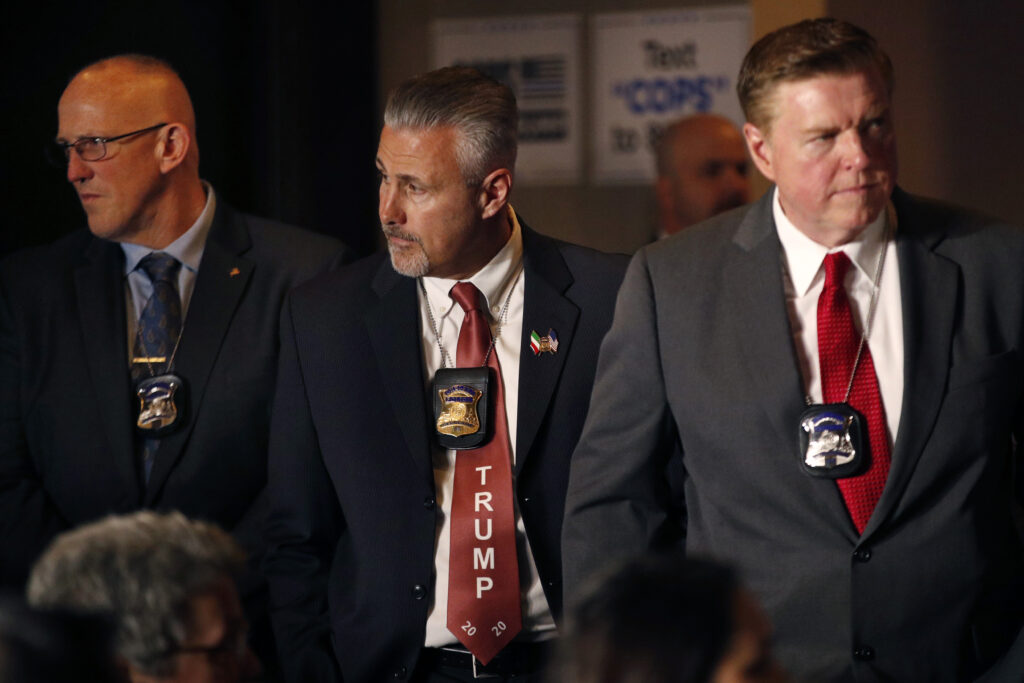
THE question in the 2020 presidential race is whether the polls are missing “hidden” Trump supporters, just as they did in 2016.

If they miss again, a big part of the overlooked population may be the nation’s 800,000 cops. Randy Hagler, President of the Fraternal Order of Police in North Carolina, the largest police union in the state, says, “I never answer poll calls. If I do by mistake, I hang up right away. I think most police do the same.”
If polls are failing to capture the police, they are missing something hidden in plain sight. Every major police organization has endorsed Trump. Police groups nationwide have endorsed Republicans in overwhelming numbers at all levels of government. In this year’s 46 races for U.S. senate and governor, major police organizations have endorsed only three Democrats, including two whose Republican opponents have also received major police endorsements.
It is an understatement to say cops are upset with Biden and the Democrats for aligning with Black Lives Matter and BLM’s charges of systemic police racism and its calls to defund the police. This anger calls to mind the old saying in politics that your friends may vote for you on a sunny day, but your enemies will trudge through rain, snow, sleet and ice to vote against you.
This year, Hagler says “We’re dialed up,” and sees turnout over 90%, with all of the 15% increase going to Trump and the GOP. He told me that the North Carolina FOP has endorsed every GOP candidate for federal office with a “98% level” of sentiment.
Within the context of the electoral college, only certain states with close races matter. North Carolina is one of them.
Real Clear Politics lists 12 states as toss-ups, including North Carolina.
In 2016, Trump won 10 of the 12. This year, the RCP poll averages show Trump leading in just two. It looks dire for Trump.
Within the toss-up group, there are six (including North Carolina), which RCP labels “Top Battleground” states. At present, Biden holds only a 3.4% lead in the “2-days to Election” Top Battleground average, better than Hillary Clinton’s 1.6% “3-days-to-go” advantage in 2016, but still within the margin of error. Thus, the race looks closer than by the line-up of toss-up states now favoring Biden.
Furthermore, Trump is leading in the Top Battleground states according to the one polling outfit which got 2016 correct, Trafalgar Group, which has Trump ahead by 1.7% based on an average of its latest poll in each of the Top Battleground states. So, the race may be very, very close.
Let’s translate poll percentages into numbers of votes. In 2016, a combined total of about 31 million votes were cast in the Top Battleground states out of a total of about 137 million votes cast nationally. Looking at the Top Battleground states using the 2016 voting totals, Biden is ahead this year by about 1,050,000 votes according to the RCP average and Trump leads by 530,000 votes according to Trafalgar.
Could the increased participation of police change the outcome?
Multiplying 27,000 by a factor of six produces a potential impact of about 162,000 votes in the Top Battleground states. Now, we’re talking real numbers.
Mathematically, it is quite plausible that police could have a significant impact on the election outcome by providing the last votes to push Trump over the top in close races such as Michigan and Wisconsin in 2016 where Trump won by just 11,000 and 23,000 votes, respectively.
Are pollsters missing this police effect? In 2016, they missed poll-shy non-college educated Trump supporters who were embarrassed by their low educational attainment. Since then, pollsters have adjusted their methodology for the so-called “diploma divide.”
If they haven’t been able to reach poll-shy cops this year, have they made methodological adjustments? Not likely.
Beyond voting, I asked Hagler what else he and other cops are doing this year – are they becoming involved in campaigns.
Hagler said he and his fellow FOP state board members are encouraging their 6,000 rank and file members in their 50 local lodges to engage the public, telling officers that “they can get 10 votes with alert community engagement and outreach.”
Hagler says the FOP has consistently requested blocks of 50 or more seats at every Trump-Pence rally in state. FOP members are snapping them up. Hagler says “This is unusual. We haven’t done this before.” President Trump held a rally in Hickory over the weekend.
If pollsters are missing, or failing to account for, “silent Trump voters” again this year, cops are likely to be a significant part of the silence, both by their numbers and by their enthusiasm.
![]()
Red Jahncke is a nationally recognized columnist, who writes about politics and policy. His columns appear in numerous national publications, such as The Wall Street Journal, Bloomberg, USA Today, The Hill, Issues & Insights and National Review as well as many Connecticut newspapers.

